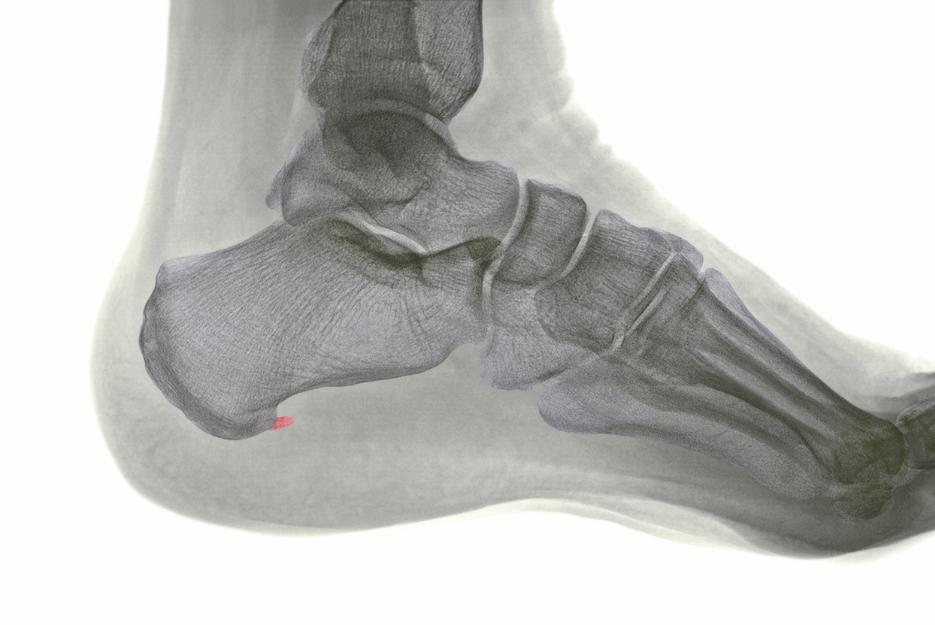Heel Spur Treatment
Background
If you’re experiencing ongoing heel pain, especially pain that worsens in the morning or when standing after rest, you may have developed a heel spur. However, it’s important to understand that a heel spur is not typically the direct cause of your heel pain.
Heel spurs are often a secondary result of an underlying condition, such as plantar fasciitis or Achilles tendonitis. By addressing these root causes, symptoms generally improve, and heel spurs usually don’t require specific treatment.
Despite some health professionals suggesting that heel spurs cause heel pain, this is a misconception. Studies have shown that many people with heel pain don’t have heel spurs, and conversely, many people with heel spurs experience no pain at all.

Table of Contents
What Is A Heel Spur?
Who Is Prone To Heel Spurs?
Heel spurs can develop in anyone who has had plantar fasciitis or Achilles tendonitis for a prolonged period, typically over 6-8 weeks. Certain groups may have a higher likelihood of developing heel spurs, including:
- Women: Regularly wearing high-heeled shoes can shorten the Achilles tendon over time, increasing the risk of heel spur formation.
- Older adults: Years of wear and tear on the feet can contribute to heel spurs. Additionally, older adults are more likely to have a thinner fat pad on the heel (Fat Pad Syndrome), which reduces cushioning and may heighten the risk.
- Active individuals: Those involved in high levels of physical activity, such as athletes or sports enthusiasts, are more prone to heel spurs, especially if they’ve experienced persistent heel pain over the years.
Visit Us Today
Hope Island
Phone: 07 5510 9222
Located within Hope Island Marketplace Medical & Skin Clinic, 99-103 Broadwater Ave Hope Island QLD 4212
Jimboomba
Phone: 07 5546 9766
Located Within Jimboomba Medical Centre, Unit 1/69 Cerina Cct, Jimboomba QLD 4280
Beenleigh
Phone: 07 3287 2224
Located Within Beenleigh Mall Medical Centre, Shop24A, 40/68 Main Street, Beenleigh QLD 4207
Eagleby
Phone: 07 2889 1666
Located Within Eagleby Family Practice, 5/120 River Hills Rd, Eagleby QLD 4207
Harristown
Phone: 07 4635 6111
Located Within Toowoomba Medical Centre, 146 Drayton Road, Harristown QLD 4350
Marsden
Phone: 07 3067 2370
Located Within Marsden Family Doctors, Shop 28/55-77 Chambers Flat Rd, Marsden QLD 4132
Keperra
Phone: 07 3355 4082
Located Within Keperra Medical Clinic, 14 Dallas Parade Keperra QLD 4054
Coomera
Phone: 07 5573 5663
Located Within Doctors @ Coomera Central, Shop 6, 21 Coomera Grand Drive, Upper Coomera, QLD 4209
Newtown
Phone: 07 4633 8700
Located Within Ochre Medical Centre Wyalla, Shop 20, 238 Taylor Street, Newtown QLD 4350
Heel Spur Treatment
Since a heel spur, if present, is often not the source of heel pain, the first step in addressing the pain is to accurately diagnose its underlying cause. Common causes include the plantar fascia, Achilles tendon, or other structures around the heel, such as the fat pad.
Treatment will be tailored to the specific diagnosis. In many cases, underlying foot and gait issues, such as excess pronation (feet rolling inward) or supination (feet rolling outward), contribute to the problem and need to be addressed.
Focusing on treating the damaged structures often resolves pain and symptoms entirely. If symptoms persist, surgery to remove the heel spur may be considered, but this is typically a last resort. The best approach to heel pain remains prevention through early intervention and management.
Enquire Now
Heel Spur FAQ's
What are helpful heel spur exercises?
How do i get rid of heel spurs?
What are heel spur symptoms?
The most common symptom of a heel spur is heel pain, which may feel like a sharp pain when standing or a constant dull ache. In some cases, a small bony protrusion may be visible under the heel, which can be tender and make walking barefoot uncomfortable.
However, not everyone with a heel spur experiences symptoms. The only definitive way to confirm the presence of heel spurs is through an X-ray.
What causes heel spurs?
Are heel spurs hereditary?
Not The Condition You Are Looking For?
Find out more about the conditions we treat by clicking below.
